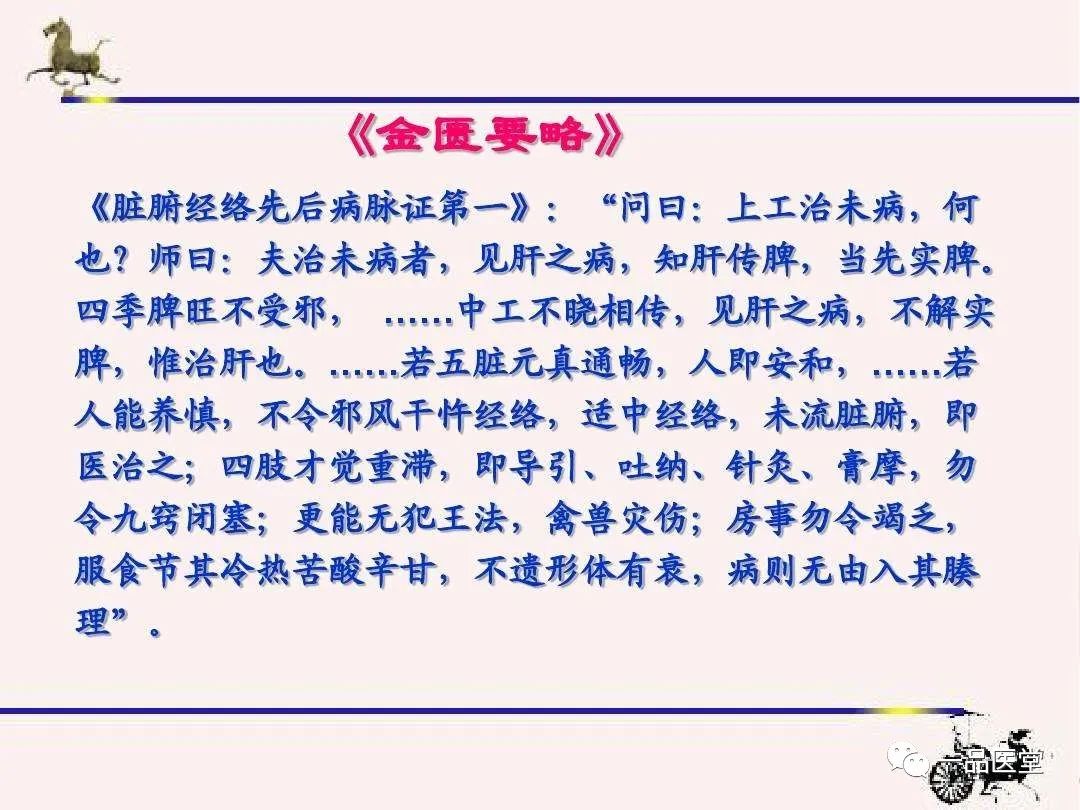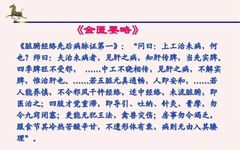The First Chapter: Diseases and Syndromes of the Zang-Fu Organs and Meridians

Original Text: The question is: Why does a skilled physician treat diseases before they manifest? The master replied: To treat diseases before they manifest means to recognize the disease of the liver and understand that it transmits to the spleen. One must first strengthen the spleen; if the spleen is strong throughout the four seasons and does not suffer from pathogens, then there is no need to tonify it. A mediocre physician does not understand the transmission of diseases; upon seeing liver disease, they only treat the liver. For liver diseases, sour herbs are used to tonify, bitter herbs are used to assist, and sweet herbs are used to harmonize. Sour enters the liver, bitter enters the heart, and sweet enters the spleen. The spleen can harm the kidneys; if kidney qi is weak, then water does not flow; if water does not flow, then heart fire becomes excessive; if heart fire is excessive, it harms the lungs; if the lungs are harmed, then metal qi does not flow; if metal qi does not flow, then liver qi becomes excessive. Therefore, by strengthening the spleen, the liver can heal itself. This is the essential method of treating liver diseases by tonifying the spleen. If the liver is deficient, this method is applicable; if it is excessive, it is not necessary.
The classic states: “Deficiency and excess, tonify the insufficient, reduce the excessive, this is its meaning.” The other organs follow this principle.
Note: The first paragraph discusses the disease of liver excess, which must transmit to the spleen. A skilled physician can foresee what diseases may develop if the current condition progresses. Therefore, while treating the current disease, they must also prevent potential diseases that have not yet manifested. Upon seeing liver disease, one must understand that the liver transmits to the spleen and must first strengthen the spleen. Throughout the four seasons, if the spleen is strong and does not suffer from pathogens, then there is no need to tonify it. For example, in treating liver disease, according to the theory of the five elements, the liver belongs to wood and the spleen belongs to earth. If the liver is excessive, wood will certainly overcome earth; thus, upon seeing liver disease, one must know that the liver transmits to the spleen, and in treatment, one must treat the liver while also strengthening the spleen (i.e., tonifying the spleen) to prevent the disease from transmitting, as currently, it is only liver disease and the spleen is not yet affected, which is treating the disease before it manifests. However, there is an exception: one must understand the principles of the transmission of the five organs and the seasonal changes. The statement that the spleen is strong and does not suffer from pathogens throughout the four seasons means that according to the heavenly stems and earthly branches, there is always an earth element in each season, and the last eighteen days of each season are times of strong earth. At this time, although there is liver disease, because the spleen is strong and does not suffer from pathogens, there is no need to tonify the spleen. A mediocre physician does not understand the transmission of diseases; upon seeing liver disease, they only treat the liver without realizing that the spleen may also be affected and should be strengthened first.
The second paragraph discusses liver deficiency. For tonification, sour herbs are used, bitter herbs are used to assist, and sweet herbs are used to harmonize. Sour enters the liver, bitter enters the heart, and sweet enters the spleen, explaining how to use herbs for treating liver deficiency. For deficiency syndromes, tonification methods are used; liver deficiency is tonified with sour flavors because sour enters the liver; wood generates fire, and the heart is the child of the liver. If the liver is deficient, heart fire will also be insufficient, and tonifying the child can strengthen the mother. Therefore, in treating liver deficiency, one must also assist heart fire with bitter herbs, as bitter enters the heart. The “Nanjing – Fourteenth Difficult” states, “To harm the liver is to weaken the center,” where “center” refers to the spleen. Thus, in treating liver deficiency, one must also tonify the spleen with sweet herbs, as sweet enters the spleen. This has certain clinical significance. Although liver deficiency does not transmit to the spleen, tonifying the spleen is indeed a treatment for the liver, and the meaning of the above text is sufficient.
However, it goes on to explain a series of principles: the spleen can harm the kidneys… This is the essential method of treating liver deficiency by tonifying the spleen. The general idea is that the spleen has the function of restraining kidney water (earth overcomes water), but if it over-restrains, it harms the kidneys. If kidney qi is weak, then water does not flow; water overcomes fire, and now with weak kidney qi and water not flowing, it cannot restrain heart fire, leading to excessive heart fire; fire also overcomes metal, so excessive heart fire harms the lungs; if the lungs are harmed, then metal qi does not flow; if metal qi does not flow, then liver qi becomes excessive. When liver qi is excessive, the liver deficiency disease is resolved, hence it is said that the liver heals itself. This is the essential method of treating liver deficiency by tonifying the spleen.
Note: Ultimately, it is still to illustrate that treating liver deficiency also requires strengthening the spleen, which is consistent with the conclusion of the previous part of this section. The latter half of this second paragraph, even if it is to further elaborate on the mechanism, seems somewhat superfluous. Especially the phrases “If the liver is deficient, this method is applicable; if it is excessive, it is not necessary” contradict the earlier statement that upon seeing liver disease, one must first strengthen the spleen. Thus, there is an apparent contradiction. Furthermore, according to this series of principles, treatment must be sequential; is there any instance of this in Zhang Zhongjing’s writings? No! Even in this chapter, there is no example of treatment according to this.
In his last systematic explanation of the “Shang Han Za Bing Lun” (Treatise on Cold Damage and Miscellaneous Diseases), Hu Xishu stated: “Originally, in the first page of the ‘Shang Han Lun’ there is a ‘Shang Han Example,’ similar to a preface. The ‘Shang Han Example’ was written by Wang Shuhe, so I believe this chapter was also written by Wang Shuhe. The title of this chapter does not conform to Zhang Zhongjing’s writing style, and the pulse and syndrome are not consistent. This is all about the Zang-Fu organs and meridians; I believe this is not Zhang Zhongjing’s work, as he would not write in this manner, so I have never discussed it; everyone can research whether this is the case.”
Note: The classic states: “Deficiency and excess, tonify the insufficient, reduce the excessive, this is its meaning.” The classic refers to the “Huangdi Neijing” (Inner Canon of the Yellow Emperor). Deficiency and excess have two interpretations: one refers to the treatment methods for deficiency and excess. The second states that if a deficiency syndrome is treated with purging methods (methods for excess), the deficiency will become more deficient; if an excess syndrome is treated with tonification methods (methods for deficiency), the excess will become more excessive. One must tonify the insufficient and reduce the excessive; only then is it proper treatment. Liver diseases are like this, and the same applies to other organs such as the heart, lungs, spleen, and kidneys.

Hu Xishu and Feng Shilun discuss Shang Han — (12)
Formulas and syndromes are the unchanging soul of classic formulas.

